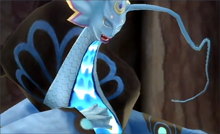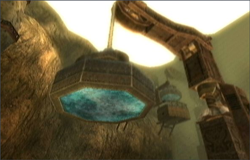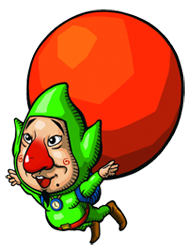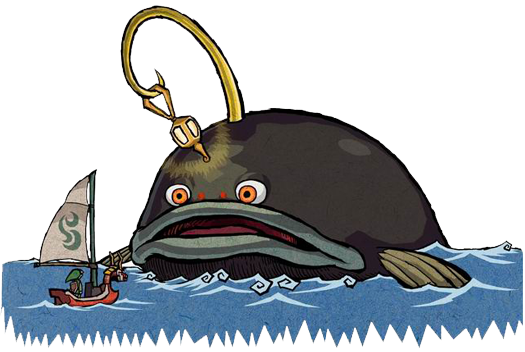The Legend of Zelda’s Eastern/Western Cultural Barrier
Posted on March 09 2012 by Djinn
 The Legend of Zelda series has captured the hearts and minds of fans across the world regardless of language and culture. However, there are a great many aspects of the series that remain misunderstood to many fans outside of Japan. Many things found in the games are completely lost on western fans. The original Legend of Zelda was a new experience for players to immerse themselves in, a fantasy world based upon western fantasy allegory with all the traditional elements like dungeons, dragons, and fairies. The inspirations of the series are obvious to most casual players, but to the more observant there are many things throughout the games that make little to no sense. Some players were left asking themselves why did a character look a certain way or what was the significance to the design of a dungeon. It is no surprise that Japanese developers would create a game for Japanese audiences and, of course, if and when that game got shipped to North America, many things would be lost in translation. Nintendo is, after all, a Japanese company that produces games for a Japanese audience. We have just had the good fortune of having many of these great titles translated and released here in the west as well.
The Legend of Zelda series has captured the hearts and minds of fans across the world regardless of language and culture. However, there are a great many aspects of the series that remain misunderstood to many fans outside of Japan. Many things found in the games are completely lost on western fans. The original Legend of Zelda was a new experience for players to immerse themselves in, a fantasy world based upon western fantasy allegory with all the traditional elements like dungeons, dragons, and fairies. The inspirations of the series are obvious to most casual players, but to the more observant there are many things throughout the games that make little to no sense. Some players were left asking themselves why did a character look a certain way or what was the significance to the design of a dungeon. It is no surprise that Japanese developers would create a game for Japanese audiences and, of course, if and when that game got shipped to North America, many things would be lost in translation. Nintendo is, after all, a Japanese company that produces games for a Japanese audience. We have just had the good fortune of having many of these great titles translated and released here in the west as well.
Clearly there are some things that work for Japanese fans that are lost on western fans and vice versa. How much does Japanese culture affect the series, and how much is that culture noticed by western fans? Does the cultural barrier affect the story so strongly that it has an impact on the quality of the game?
There are many unusual occurrences throughout the series that are not understood and even ignored by western players but weren’t strange at all to Japanese players. Later on, as the games became more sophisticated, the cultural influence within them became more noticeable. The need for more story, more characterization, and more detail meant that more could be added into the games to create a greater experience for the player. Gradually, the world of Hyrule became less of a medieval land and more of an amalgamation of various cultures and periods.
During this effort to create a deeper story for the games, many of the additions included a mythology to compliment the story, many more villages for Link to visit, and a colorful cast of characters found in various worlds besides Hyrule. The series does maintain a very western medieval fantasy look to it in most cases, but there is still the occasional subtle nuance that an observant player can catch, something different. The traditional costume of the people of Ordon Village, for example, is distinctly non-western in appearance.
Another notable example can be found in many of the deities seen in the games. Players often don’t fully understand the system they represent or they simply write these odd characters off as something magical and mysterious. The twin deities Cyclos and Zephos of The Wind Waker are largely an enigma to many western fans who have little understanding of or familiarity with a god that appears as a small frog riding on a cloud; it’s uncommon to see such a small and unusual creature portrayed as a god or deity in western cultures. The Great Deku tree and the large fish Jabu Jabu, known as the spirits of earth and water, also confound those not quite accustomed to the idea of a deified tree or oversized creature, concepts often seen among the deities of Shintoism. The lofty dragons of Skyward Sword that help Link learn the song of the Hero are another example of eastern cultural influence appearing in the game. Their appearance is less monstrous and more that of friendly eldritch beings that wear elaborate robes and proudly serve the gods.
It is not just in aspects of the story alone that the evidence of Japanese culture appears. There is a strong divide between what players actually want in a game when it comes to fans in different hemispheres. Japanese players often have a more specific taste which can sometimes be vastly different from that of western fans. The open world games that work out so well in the west which place emphasis on freedom for the player to make their own choices and go where they please are not common in Japanese markets. Japanese fans prefer a guided experience involving a much more traditional story and detailed setting. The games tend to be very story driven and rarely deviate from the main quest.
“Japanese players do not like being thrown into an arena in which they are given very little instruction,”
-Hideo Kojima, creator of the popular “Metal Gear Solid” series
Overall, the Zelda series follows traditional Japanese game design conventions, and they can be very different from western ones. Most often Japanese games are linear and follow a storyline from beginning to end. Western games however are often open-ended with multiple story angles for the player to choose. This level of freedom for the player has led to the creation of new genres in the west, while the traditional story-driven gameplay has thrived in Japan.
Most current Zelda games maintain this story-driven style and leave little room for the player to chose their own path. This is a large contrast from the early games in the series, which allowed the player to have absolute freedom to go wherever they wished and discover the levels on their own. Slowly the series transformed from allowing more freedom for the player to having a much greater story for the player to follow while restricting their choices within the gameplay.
Western games often follow a much darker and more realistic trend consisting of landscapes with less colorful characters. Gritty visuals and dark subject matter are becoming more common in western fantasy games. They often draw inspiration from movies by involving elaborate detailed scenery and orchestral scores, recreating the cinematic experience in a game.
While western fans appreciate darker and edgier games, eastern ones tend to move toward lighter and softer games. Similarly western games tend to have much smaller fanbases consisting of specific demographics, whereas eastern games can have much broader fanbases, including different age groups and genders. These separate attitudes towards the style of a game can often clash between cultures.
 Twilight Princess is easily considered the most “westernized” entry in the series, as it borrows many different elements from modern fantasy games. It was clear that the artistic style was meant to appeal to those who did not care for the more cartoony look of The Wind Waker. This resulted in poor sales with the Japanese audience and complaints from fans calling it a dark Zelda game. This has also caused many critics to call it bland and uninteresting, citing that all of the unique visuals that the series had until that point were simply dropped in an effort to imitate other western fantasy games like The Elder Scrolls series.
Twilight Princess is easily considered the most “westernized” entry in the series, as it borrows many different elements from modern fantasy games. It was clear that the artistic style was meant to appeal to those who did not care for the more cartoony look of The Wind Waker. This resulted in poor sales with the Japanese audience and complaints from fans calling it a dark Zelda game. This has also caused many critics to call it bland and uninteresting, citing that all of the unique visuals that the series had until that point were simply dropped in an effort to imitate other western fantasy games like The Elder Scrolls series.
Japanese players have grown up reading manga and watching anime, so it is no surprise that their visual medium of choice is reflected in the games produced for them. Most anime tend to be very bright and colorful, often with childish and exaggerated characters, which in turn becomes an accepted visual style in other Japanese media like video games. This greatly sets Japanese games apart from the television and movie inspired gritty realism that is so often seen in western games.
Clearly, anime and manga have had a great amount of influence on the series, as most notably seen in Ocarina of Time and Majora’s Mask, which utilize the anime style rather than a more unique one like the games that came before and after. Manga and anime being leading forms of popular media in Japan, it is not at all surprising that there would be an anime influence in the series. Writers and developers often look to other forms of storytelling to draw from when working on their own creations.
The presence of Japanese humor is also not always picked up by Western fans. Western humor can often be very physical and direct; Japanese humor and jokes are heavily based on wordplay and puns. One cannot deny that there is of a lot of light-hearted humor in The Wind Waker and Skyward Sword. Quirky lines and bizarre hairstyles that often appear less amusing but slightly odd to a western audience would be more common to Japanese players. Many fans have learned to recognize this distinct type of humor as it appears in many other forms of Japanese media as well.
Perhaps the most well known Zelda icon that never could break the cultural barrier is the character Tingle. First appearing in Majora’s Mask as a colorful side character, he has gone on to appear in several later games, even starring in his own spinoff series on the DS. He appears as an eccentric thirty five year old man who casually dresses up in strange costumes and talks about fairies occasionally saying his catchphrase “Kooloo-Limpah”; he lives in a fantasy of his own, pretending to be a fairy and tossing glitter into the air, but he still maintains his profession of map making, sometimes helping Link on his adventures for exorbitant prices. Tingle, for all of his strangeness, never caught on with western fans who considered the character a little too weird or “creepy.” He is possibly the most notoriously hated Zelda character in the west. However, he holds a huge amount of fame in Japan, enough so that he has become something of an icon among Japanese Zelda Fans. The character is now well known as a controversial aspect of the series.
 The difference in opinion regarding Tingle is a cultural one. Generally, his activities are synonymous with the stereotypical nerd cosplaying in their parent’s house. Fandom, videogames, and cosplaying are much more common and accepted in Japan; a character that is a caricature of these things in a famous videogame is not such a negative stereotype.
The difference in opinion regarding Tingle is a cultural one. Generally, his activities are synonymous with the stereotypical nerd cosplaying in their parent’s house. Fandom, videogames, and cosplaying are much more common and accepted in Japan; a character that is a caricature of these things in a famous videogame is not such a negative stereotype.
If there is one universal element of the series that keeps the fans coming back despite all the differences between cultures, languages, and storytelling conventions, it is the gameplay. The Zelda series has maintained the perfect blend of action, puzzles, story, and unique situations to keep fans around the world happy and hungry for more despite their differences. Because of this, the Zelda series cannot easily be called a stereotypically Japanese or western game as it fuses the elements of both. The series maintains a distinct identity despite a few components failing to break the culture barrier between the fans.




